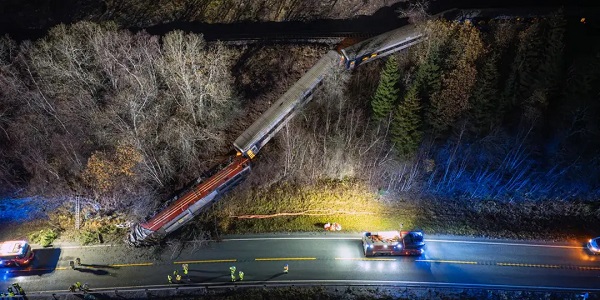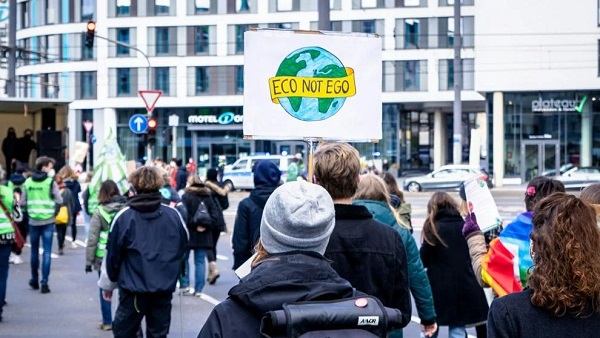Business
Norway’s Trainwreck – How Taxing Unrealized Gains Has Caused an Entrepreneurial Exodus

From hagaet the substack of Fredrik Haga, co-founder of Dune
Norway Shrugged
Recently, my story as a Norwegian entrepreneur facing an unrealized gains wealth tax bill many ties higher than my net income went viral, amassing over 100 million views on X. A few years ago I publicly called out that this tax is both impossible-to-pay and nonsensical, but no politician would listen. So I made the difficult decision to leave my home country. I still don’t know how I was supposed to pay the tax, but I recently found myself plastered on the “Wall of Shame” at the Socialist Left Party’s offices.
In this post, I’ll delve into why there’s an entrepreneurial exodus from Norway, how we got here, and what the future might hold.

Socialist Left leader and me on the “Wall of Shame” (Dagbladet)
Norway: A real life Atlas Shrugged
Ayn Rand’s 1957 novel Atlas Shrugged paints a vivid picture of a dystopian society where government overreach and socialist policies kill innovation and demonize entrepreneurs. In Rand’s world, working hard and taking risks is not celebrated, but looked at with suspicion. As the government tightens its grip, mandating how businesses should operate, the nation’s entrepreneurs begin to vanish and are nowhere to be found. People get poorer while the state keeps growing. Step by step the functioning of society starts to crumble. The trains first go off schedule, then start crashing and eventually stop going all together.
Present-day Norway mirrors this dystopia in unsettling ways. Taking risk with your own money, working hard and then making a profit is frowned upon. While politicians spending the people’s money on non-viable green projects, and delivering dysfunctional public services at high costs has the moral high ground. The government is spending 35 Billion NOK on offshore wind that industry experts think is financially unviable. This is about the same amount as the total wealth tax revenues. Norway spends 45% more than Sweden on health care per capita with approximately the same health outcomes. Norway has 2,5 times bigger share of the working population on sick leave than Denmark. Norway spends ~50% more than Finland on primary and secondary school with worse results.
With unshakeable ideological conviction, socialist politicians are rapidly undermining Norway’s wealth creation. They’re imposing taxes that explicitly disadvantage Norwegian business owners, and are often straight up impossible to pay. When confronted with the reality that you can’t pay taxes with money you don’t have—or that loss-making businesses can’t afford massive dividends just to cover owners’ wealth taxes—the response is vague moralism like “Those with the broadest shoulders must bear the heaviest burdens.” Any argument against any part of the system is by default invalid because there’s free health care…
Norway’s entrepreneurs are now indeed disappearing from society. In the past two years alone, a staggering 100 of Norway’s top 400 taxpayers, representing about 50% of that group’s wealth, have fled the country to protect their businesses.
Norwegian trains have for a long time been notoriously unreliable – even less reliable then in war time Ukraine! In chilling similarity to Atlas Shrugged there’ve been two train crashes, including one fatal, in the last month alone.

Tram crashing into a retail store in Oslo 29th of October 2024 (NRK)
The Unrealized Gains Wealth Tax: A Self-Inflicted Wound
Norway imposes a wealth tax that taxes unrealized gains at approximately 1% annually. Calculated on the full market value for publicly traded assets and the book value of private companies. On New Year’s Eve, whatever your net worth – including illiquid assets – is subject to this tax. It doesn’t matter if you’re running a loss-making startup with no cash flow, if your investments have tanked after the valuation date, or even if your company has gone bankrupt—you still owe the tax.
This creates a perverse scenario where business owners must extract dividends or sell shares every year just to cover their tax bill. With dividend and capital gains taxes at around 38%, you need to withdraw approximately 1.6 million NOK to pay a 1 million NOK wealth tax bill. You’re essentially paying taxes to pay taxes, draining capital from your business without any personal financial gain.
Moreover, the tax incentivizes Norwegians to take on excessive debt to reduce their taxable wealth, inflating housing prices and making the economy more fragile. While real estate and oil companies can mitigate this through debt financing, tech startups—often equity-financed and loss-making for years—are disproportionately harmed.
The Berlin Wall Exit Tax: Another Tax on Unrealized Gains
After witnessing a mass exodus of top taxpayers, the Norwegian government had a golden opportunity to reassess its policies. The wealth tax contributes less than 2% to the state budget; eliminating it and marginally increasing capital gains, corporate, or dividend taxes could have halted the entrepreneurial bleeding without affecting government budgets.
Instead, the government doubled down on what’s not working, introducing an exit tax on unrealized gains. Now, if you choose to move from Norway, you’re immediately liable to pay 38% of the total market value of your assets upon departure. It doesn’t matter if you have no liquidity, if your assets are high-risk and could plummet in value, or even if your company does fail after you leave—you still owe the tax. Previously, entrepreneurs could at least relocate if the wealth tax became too burdensome. Now, they’re incentivized to leave before they even start their businesses.
The government could have listened to the tornado of negative feedback and adjusted course, but instead, they doubled down on what’s not working. When the Berlin wall was created it was clear which side of the city had the better system… the one that didn’t have to build a wall to retain its citizens. Instead of trying to attract and retrain capital and talent by making Norway a better place for business the Norwegian government chose to build its very own Berlin Tax Wall with yet another tax on unrealized gains. Trapping not only entrepreneurs, but anyone with more than $270k of wealth wanting to move their life abroad for whatever reason…
The first 50 years: Well Managed Oil Wealth
Norway is one of the richest countries in the world. The government does not need to send their entrepreneurs abroad with non-sensical taxes. So you may ask yourself, “Well, how did we get here?”.
In fact, the oil wealth has been amazingly well managed by the politicians for almost half a century. In 1969, Norway struck oil—a discovery that could have led to the same resource curse that plagued other nations. Instead, Norwegian politicians made two genius decisions that benefited the entire population.
- Genius Move 1: Taxing Oil Profits at 80%Recognizing the need for foreign expertise but unwilling to let international corporations reap all the benefits, Norway taxed oil company profits at a staggering 80%. This bold move ensured that the wealth generated from the oil benefited the Norwegian people.
- Genius Move 2: Establishing the Sovereign Wealth FundIn the 1990s, Norwegian politicians understood that oil is a finite volatile resource and that it would be irresponsible to spend all the oil revenue on a running basis. In an act of rare political austerity and long term thinking they created the Oil Fund, to diversify and invest surplus revenues internationally. Furthermore the “Budgetary Rule” limited annual government spending from the fund to 3%, ensuring the fund in theory goes on forever.
For two decades, politicians across the spectrum adhered to this prudent financial management, displaying an impressive level of restraint and foresight rarely seen in politics.
How Oil Wealth Led to Socialist Ideology over Wealth Creation
But success bred complacency. In theory, everybody agrees that Norway needs new post-oil industries for the long term. In practice, the abundance of oil wealth has led to a detachment from the realities of how wealth and economic growth is created. While the Norwegian politicians impressively managed to restrain themselves for about half a century the current generation are now acting as if tax money grows on trees.
Ultimately that is the paradox that has caused the current situation: because the state has so much money, it is no longer at the mercy of businesses actually being created and staying in Norway. At least as long as the oil wealth lasts.
The 2025 Election: No Fundamental Solution in Sight
It seems likely there will be a new government after the 2025 elections, as the current government is seeing record-low support in the polls. Unfortunately, even seemingly business friendly opposition parties like the Conservative Party (Høyre) and the Liberals (Venstre) are not committed to abolishing the wealth tax entirely. They propose valuing companies zero for wealth tax purposes—a good step in the right direction, but not a fundamental solution to Norway’s ongoing crisis. Unfortunately The Progress Party (Fremskrittspartiet) is the only party that wants to remove the tax completely.
The wealth tax’s mere existence continues to create absurd incentives for excessive debt and over-investment in housing, detracting from more productive investments like stocks and startups. Moreover, the possibility of future governments reinstating the wealth tax for companies keeps the harmful uncertainty for businesses very much alive.
Many European countries have recognized the harm caused by taxing unrealized gains and abandoned it. Norway’s neighbor Sweden abolished its wealth tax in 2007. Since then they’ve seen its tech sector flourish. Spotify recently surpassed Norway’s state-owned oil company, Equinor, in market capitalization. In the last 15 years Norway has gone from having 7 to now only 2 of the Nordics top 30 most valuable companies.
Norway has produced four “unicorns”. Since then we the founders of Dune and Cognite have left due to the unreasonable taxes. Oda operates domestically in Norway. All founders have left the company and are wiped out. The last one Gelato is run by a swede that would likely move if they need to raise more money.
The Extra Long Journey to Post-Oil Wealth and Welfare
In Atlas Shrugged, the entrepreneurs refuse to return to society until the oppressive system collapses entirely. I sincerely hope Norway doesn’t have to endure such a downfall before entrepreneurs can return.
Fortunately Norway has a highly educated population and a lot of capital. With oil a high tech industry has been built in Norway before. What’s lacking is the political will to encourage entrepreneurship and big ambitions, not punish it.
Trust is built in millimeters and torn down in meters. In just a few years, the trust in Norway as a viable place to build and invest has been shattered. A whole generation of entrepreneurs has been lost.
The people of Norway currently enjoy and benefit from a host of generous welfare benefits. High income with short work days, free healthcare, free daycare, free education and beyond. For this to continue in the future Norway needs massive new post-oil industries. Due to the politicians’ series of unforced errors, the journey to get there will be extra long and painful. A definitive abolishment of all taxes on unrealized capital gains is the obvious first step.

Business
China, Mexico, Canada Flagged in $1.4 Billion Fentanyl Trade by U.S. Financial Watchdog

 Sam Cooper
Sam Cooper
The U.S. Treasury’s Financial Crimes Enforcement Network (FinCEN) has identified $1.4 billion in fentanyl-linked suspicious transactions, naming China, Mexico, Canada, and India as key foreign touchpoints in the global production and laundering network. The analysis, based on 1,246 Bank Secrecy Act filings submitted in 2024, tracks financial activity spanning chemical purchases, trafficking logistics, and international money laundering operations.
The data reveals that Mexico and the People’s Republic of China were the two most frequently named foreign jurisdictions in financial intelligence gathered by FinCEN. Most of the flagged transactions originated in U.S. cities, the report notes, due to the “domestic nature” of Bank Secrecy Act data collection. Among foreign jurisdictions, Mexico, China, Hong Kong, and Canada were cited most often in fentanyl-related financial activity.
The FinCEN report points to Mexico as the epicenter of illicit fentanyl production, with Mexican cartels importing precursor chemicals from China and laundering proceeds through complex financial routes involving U.S., Canadian, and Hong Kong-based actors.
The findings also align with testimony from U.S. and Canadian law enforcement veterans who have told The Bureau that Chinese state-linked actors sit atop a decentralized but industrialized global fentanyl economy—supplying precursors, pill presses, and financing tools that rely on trade-based money laundering and professional money brokers operating across North America.
“Filers also identified PRC-based subjects in reported money laundering activity, including suspected trade-based money laundering schemes that leveraged the Chinese export sector,” the report says.
A point emphasized by Canadian and U.S. experts—including former U.S. State Department investigator Dr. David Asher—that professional Chinese money laundering networks operating in North America are significantly commanded by Chinese Communist Party–linked Triad bosses based in Ontario and British Columbia—is not explored in detail in this particular FinCEN report.¹
Chinese chemical manufacturers—primarily based in Guangdong, Zhejiang, and Hebei provinces—were repeatedly cited for selling fentanyl precursors via wire transfers and money service businesses. These sales were often facilitated through e-commerce platforms, suggesting that China’s global retail footprint conceals a lethal underground market—one that ultimately fuels a North American public health crisis. In many cases, the logistics were sophisticated: some Chinese companies even offered delivery guarantees and customs clearance for precursor shipments, raising red flags for enforcement officials.
While China’s industrial base dominates the global fentanyl supply chain, Mexican cartels are the next most prominent state-like actors in the ecosystem—but the report emphasizes that Canada and India are rising contributors.
“Subjects in other foreign countries—including Canada, the Dominican Republic, and India—highlight the presence of alternative suppliers of precursor chemicals and fentanyl,” the report says.
“Canada-based subjects were primarily identified by Bank Secrecy Act filers due to their suspected involvement in drug trafficking organizations allegedly sourcing fentanyl and other drugs from traditional drug source countries, such as Mexico,” it explains, adding that banking intelligence “identified activity indicative of Canada-based individuals and companies purchasing precursor chemicals and laboratory equipment that may be related to the synthesis of fentanyl in Canada. Canada-based subjects were primarily reported with addresses in the provinces of British Columbia and Ontario.”
FinCEN also flagged activity from Hong Kong-based shell companies—often subsidiaries or intermediaries for Chinese chemical exporters. These entities were used to obscure the PRC’s role in transactions and to move funds through U.S.-linked bank corridors.
Breaking down the fascinating and deadly world of Chinese underground banking used to move fentanyl profits from American cities back to producers, the report explains how Chinese nationals in North America are quietly enlisted to move large volumes of cash across borders—without ever triggering traditional wire transfers.
These networks, formally known as Chinese Money Laundering Organizations (CMLOs), operate within a global underground banking system that uses “mirror transfers.” In this system, a Chinese citizen with renminbi in China pays a local broker, while the U.S. dollar equivalent is handed over—often in cash—to a recipient in cities like Los Angeles or New York who may have no connection to the original Chinese depositor aside from their role in the laundering network. The renminbi, meanwhile, is used inside China to purchase goods such as electronics, which are then exported to Mexico and delivered to cartel-linked recipients.
FinCEN reports that US-based money couriers—often Chinese visa holders—were observed depositing large amounts of cash into bank accounts linked to everyday storefront businesses, including nail salons and restaurants. Some of the cash was then used to purchase cashier’s checks, a common method used to obscure the origin and destination of the funds. To banks, the activity might initially appear consistent with a legitimate business. However, modern AI-powered transaction monitoring systems are increasingly capable of flagging unusual patterns—such as small businesses conducting large or repetitive transfers that appear disproportionate to their stated operations.
On the Mexican side, nearly one-third of reports named subjects located in Sinaloa and Jalisco, regions long controlled by the Sinaloa Cartel and Cartel Jalisco Nueva Generación. Individuals in these states were often cited as recipients of wire transfers from U.S.-based senders suspected of repatriating drug proceeds. Others were flagged as originators of payments to Chinese chemical suppliers, raising alarms about front companies and brokers operating under false pretenses.
The report outlines multiple cases where Mexican chemical brokers used generic payment descriptions such as “goods” or “services” to mask wire transfers to China. Some of these transactions passed through U.S.-based intermediaries, including firms owned by Chinese nationals. These shell companies were often registered in unrelated sectors—like marketing, construction, or hardware—and exhibited red flags such as long dormancy followed by sudden spikes in large transactions.
Within the United States, California, Florida, and New York were most commonly identified in fentanyl-related financial filings. These locations serve as key hubs for distribution and as collection points for laundering proceeds. Cash deposits and peer-to-peer payment platforms were the most cited methods for fentanyl-linked transactions, appearing in 54 percent and 51 percent of filings, respectively.
A significant number of flagged transactions included slang terms and emojis—such as “blues,” “ills,” or blue dots—in memo fields. Structured cash deposits were commonly made across multiple branches or ATMs, often linked to otherwise legitimate businesses such as restaurants, salons, and trucking firms.
FinCEN also tracked a growing number of trade-based laundering schemes, in which proceeds from fentanyl sales were used to buy electronics and vaping devices. In one case, U.S.-based companies owned by Chinese nationals made outbound payments to Chinese manufacturers, using funds pooled from retail accounts and shell companies. These goods were then shipped to Mexico, closing the laundering loop.
Another key laundering method involved cryptocurrency. Nearly 10 percent of all fentanyl-related reports involved virtual currency, with Bitcoin the most commonly cited, followed by Ethereum and Litecoin. FinCEN flagged twenty darknet marketplaces as suspected hubs for fentanyl distribution and cited failures by some digital asset platforms to catch red-flag activity.
Overall, FinCEN warns that fentanyl-linked funds continue to enter the U.S. financial system through loosely regulated or poorly monitored channels, even as law enforcement ramps up enforcement. The Drug Enforcement Administration reported seizures of over 55 million counterfeit fentanyl pills in 2024 alone.
The broader pattern is unmistakable: precursor chemicals flow from China, manufacturing occurs in Mexico, Canada plays an increasing role in chemical acquisition and potential synthesis, and drugs and proceeds flood into the United States, supported by global financial tools and trade structures. The same infrastructure that enables lawful commerce is being manipulated to sustain the deadliest synthetic drug crisis in modern history.
The Bureau is a reader-supported publication.
To receive new posts and support my work, consider becoming a free or paid subscriber.
Invite your friends and earn rewards
2025 Federal Election
Canada drops retaliatory tariffs on automakers, pauses other tariffs

 MxM News
MxM News
Quick Hit:
Canada has announced it will roll back retaliatory tariffs on automakers and pause several other tariff measures aimed at the United States. The move, unveiled by Finance Minister François-Philippe Champagne, is designed to give Canadian manufacturers breathing room to adjust their supply chains and reduce reliance on American imports.
Key Details:
- Canada will suspend 25% tariffs on U.S. vehicles for automakers that maintain production, employment, and investment in Canada.
- A broader six-month pause on tariffs for other U.S. imports is intended to help Canadian sectors transition to domestic sourcing.
- A new loan facility will support large Canadian companies that were financially stable before the tariffs but are now struggling.
Diving Deeper:
Ottawa is shifting its approach to the escalating trade war with Washington, softening its economic blows in a calculated effort to stabilize domestic manufacturing. On Tuesday, Finance Minister François-Philippe Champagne outlined a new set of trade policies that provide conditional relief from retaliatory tariffs that have been in place since March. Automakers, the hardest-hit sector, will now be eligible to import U.S. vehicles duty-free—provided they continue to meet criteria that include ongoing production and investment in Canada.
“From day one, the government has reacted with strength and determination to the unjust tariffs imposed by the United States on Canadian goods,” Champagne stated. “We’re giving Canadian companies and entities more time to adjust their supply chains and become less dependent on U.S. suppliers.”
The tariff battle, which escalated in April with Canada slapping a 25% tax on U.S.-imported vehicles, had caused severe anxiety within Canada’s auto industry. John D’Agnolo, president of Unifor Local 200, which represents Ford employees in Windsor, warned the BBC the situation “has created havoc” and could trigger a recession.
Speculation about a possible Honda factory relocation to the U.S. only added to the unrest. But Ontario Premier Doug Ford and federal officials were quick to tamp down the rumors. Honda Canada affirmed its commitment to Canadian operations, saying its Alliston facility “will operate at full capacity for the foreseeable future.”
Prime Minister Mark Carney reinforced the message that the relief isn’t unconditional. “Our counter-tariffs won’t apply if they (automakers) continue to produce, continue to employ, continue to invest in Canada,” he said during a campaign event. “If they don’t, they will get 25% tariffs on what they are importing into Canada.”
Beyond the auto sector, Champagne introduced a six-month tariff reprieve on other U.S. imports, granting time for industries to explore domestic alternatives. He also rolled out a “Large Enterprise Tariff Loan Facility” to support big businesses that were financially sound prior to the tariff regime but have since been strained.
While Canada has shown willingness to ease its retaliatory measures, there’s no indication yet that the U.S. under President Donald Trump will reciprocate. Nevertheless, Ottawa signaled its openness to further steps to protect Canadian businesses and workers, noting that “additional measures will be brought forward, as needed.”
-

 espionage1 day ago
espionage1 day agoEx-NYPD Cop Jailed in Beijing’s Transnational Repatriation Plot, Canada Remains Soft Target
-

 2025 Federal Election2 days ago
2025 Federal Election2 days agoNeil Young + Carney / Freedom Bros
-

 Business1 day ago
Business1 day agoDOGE Is Ending The ‘Eternal Life’ Of Government
-

 2025 Federal Election1 day ago
2025 Federal Election1 day agoCanada drops retaliatory tariffs on automakers, pauses other tariffs
-

 Autism2 days ago
Autism2 days agoRFK Jr. Exposes a Chilling New Autism Reality
-

 International2 days ago
International2 days agoUK Supreme Court rules ‘woman’ means biological female
-

 2025 Federal Election1 day ago
2025 Federal Election1 day agoTucker Carlson Interviews Maxime Bernier: Trump’s Tariffs, Mass Immigration, and the Oncoming Canadian Revolution
-

 2025 Federal Election23 hours ago
2025 Federal Election23 hours agoBREAKING from THE BUREAU: Pro-Beijing Group That Pushed Erin O’Toole’s Exit Warns Chinese Canadians to “Vote Carefully”









